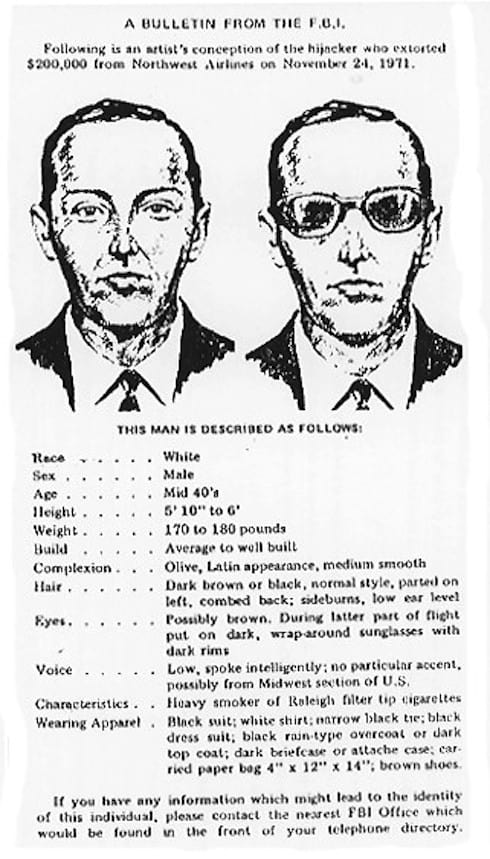Is DB Cooper dead or alive? New History documentary looks to solve legendary mystery
Is DB Cooper dead or alive? How might DB Cooper have died? Is DB Cooper even real? Where is he now? And where is DB Cooper’s money? One of the most infamous, brazen, and puzzling thefts in US history has baffled authorities for decades and given rise to a whole legion of amateur sleuths, all of whom think they have the answer to these and many other DB Cooper-related questions. Now, DB Cooper: Case Closed?, a brand-new History documentary, aims to crack the legendary case wide open, and finally solve its many mysteries.
First of all, here’s a very brief overview of the crime. On November 24, 1971, the man now known as DB Cooper boarded a plane bound from Portland to Seattle. When the plane was in the air, Cooper gave a flight attendant the following note: ” “I have a bomb in my briefcase. I will use it if necessary. I want you to sit beside me. You are being hijacked.” He demanded $200,000 in “negotiable American currency, denomination not important”; four parachutes (two primary and two reserve, possibly to mislead authorities about keeping a hostage with him); and a fuel truck ready to refuel the plane upon arrival in Seattle. The plane landed, Cooper’s demands were met, and he permitted everyone but the pilot, co-pilot, and a few crew members to leave unharmed.
Cooper informed the crew that he wanted to go to Mexico City. The pilots informed him that a second refueling would be necessary to make it, and the three men agreed to refuel again in Reno. The plane took off again, heading south, and trailed by two Air Force jets. Twenty minutes after takeoff, Cooper assembled the crew in the cockpit, and told them to close the door. He then strapped on a parachute, opened the airplane’s rear airstair…and jumped.
A thorough search of the plane upon its second landing in Reno confirmed that Cooper was no longer on board. And a months-long search of Cooper’s suspected landing area, on the ground and from the air, by a rotation of hundreds of FBI agents, US Army and Air Force soldiers, members of the Oregon Army National Guard, and police from every county involved turned up no substantive evidence of Cooper or the money. He, quite simply, got away with it.
Adding to the intrigue is the fact that there are no photographs of the man responsible for the hijacking. Here’s the best-known approximation of what Cooper looked like at the time–a composite sketch the FBI created in 1972:
A further twist to the tale is the fact that the hijacker’s actual name is Dan Cooper; “Dan” became “DB” thanks to what’s been called a “news media miscommunication.” One of the first suspects police interviewed was an Oregon man named D.B. Cooper. He was almost immediately ruled out as the hijacker, but a wire reporter on a deadline accidentaly transposed the two names. Thus, even the name “DB Cooper” is technically inaccurate, though it’s the one that almost everyone who’s ever heard of the case knows and uses.
Furthermore, as the DB Cooper documentary points out, it’s entirely possible that Cooper didn’t survive the jump. FBI Agent Larry Carr, in a discussion of the case a few years ago, contended as much: “Diving into the wilderness without a plan, without the right equipment, in such terrible conditions, he probably never even got his chute open.” Indeed, the most extensive of the searches for Cooper had to wait until spring thawed out the backcountry where Cooper was believed to have landed. And weather conditions on the night of the hijacking were rainy and very cold. At the time, Cooper was only wearing a business suit and raincoat, without apparent additional resources or aid (other than $200,000 to spend upon a successful landing).
The only significant development since the event itself came in 1980, when a family vacationing on the Columbia River in southern Washington discovered three bundles of the ransom money. The bills were “significantly disintegrated but still bundled in rubber bands,” and in the exact same sequence as when they had been given to Cooper. (The family recovered a total of 290 $20 bills, or $5,800 of the money.)
The FBI made microfilm copies of every one of the 10,000 bills that Cooper received before he received them. The agency confirms that the 290 bills represent the only money from the hijacking that has ever been recovered–the rest of the currency remains out of public circulation.
The FBI’s Wanted poster for DB Cooper
Cooper’s physical characteristics, which come from interrogations of the flight attendants, some of the passengers, and a few eyewitnesses at the Portland airport, are about the only evidence authorities have had to go on over the past forty-five years. And the characteristics are frustratingly general: a brown-eyed man approximately six feet tall and weighing roughly 180 pounds. Narrowing the list of suspects somewhat is the set of beliefs that most authorities share. For one thing, Cooper, who displayed considerable knowledge of greater Seattle’s geography, likely lived or grew up in the area. For another, he was probably an Air Force or military veteran, thanks to his offhand mid-flight identification of the Seattle-Tacoma-area McChord Air Force Base, and might even have been a pilot. His was familiar with several details of the hijacked airplane’s design that were completely unknown to civilians, and even to the flight crew. (For example, Cooper knew the airstair could be safely lowered while the plane was in the air, something that the plane’s crew did not.)
Of the men investigated closely in the ensuing years, several bear an especially striking resemblance to Cooper. One was William Gossett, a veteran of three branches of the military including the Air Force, who was openly obsessed with the details of Cooper’s story, is said to have come into possession of “wads of cash” near the end of 1971, changed his name late in life, and, while on his deathbed, confessed to the hijacking to his sons. Another was Duane Weber, a World War II veteran who served in the Army; according to Weber’s wife, he used to talk in his sleep about leaving his fingerprints on the “aft stairs” before jumping out of a plane, and, three days before his he died, told her “I am Dan Cooper.”
Most recent speculation has focused on Minnesotan Kenneth Christiansen, whose resemblance to Dan Cooper was the subject of a terrific New York Magazine feature in 2007. Though shorter and lighter than the profile of Cooper, Christiansen was likewise left-handed. And, according to Florence Schaffner, the flight attendant who took the note from Cooper, looked more like him than any of the other suspects she’d been shown.
Christiansen, a paratrooper in the US Army during World War II, paid cash for a house a few months after the hijacking. While dying of cancer in 1994, he apparently told his brother “There is something you should know, but I cannot tell you.” Then, after he died, Kenneth’s family discovered $200,000 in a secret bank account, along with a stash of gold coins and a “valuable” stamp collection. Years later, Kenneth’s brother Lyle became convinced that Kenneth was, in fact, DB Cooper, and hired a private investigator to make the strongest possible case. However, the FBI disagrees, and the case remains open.
(Even more recently, the name “DB Cooper” came up as part of a different kind of speculation. Mad Men fans will recall the brief, furious buzz during that show’s final few weeks: Don Draper was DB Cooper, and Mad Man would end with him jumping out of a plane–winding up in free fall just like in the opening credits! And then he would disappear forever–just like he’d always wanted! Needless to say, the theory did not pan out. But, in addition to being fun, it served as further proof of the American love for mystery and conspiracy.)
Perhaps the most significant proof of Cooper’s legacy is the effect his hijacking had on airport security in the United States. By the time of Cooper’s heist, hijackings had actually become rather common; America suffered 31 of them in 1972, 19 of which were “for the specific purpose of extorting money.” Beginning in 1973, the FAA required mandatory bag searches. Additionally, aircraft now come fitted with a part specifically intended to prevent lowering of the airstairs mid-flight, making getaways like Cooper’s a technical impossibility. The name of that part? The “Cooper vane.”
It should be noted that DB Cooper: Case Closed? is not the first time that History has tackled the Cooper mystery. A 2011 episode of Brad Meltzer Decoded attempted a solution, and took a long, hard look at Christiansen, as well. You can watch that episode here, in order to get your pump primed for the network’s newest take.
Speaking of which, here’s History’s tantalizing trailer for its new DB Cooper documentary:
DB Cooper: Case Closed? will air Sunday, July 10th at 9 PM on History.
(Photo credits: Is DB Cooper dead or alive via History)









